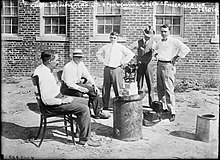



The mean center of the United States population is determined by the United States Census Bureau from the results of each national census. The Bureau defines it as follows:
The concept of the center of population as used by the U.S. Census Bureau is that of a balance point. The center of population is the point at which an imaginary, weightless, rigid, and flat (no elevation effects) surface representation of the 50 states (or 48 conterminous states for calculations made prior to 1960) and the District of Columbia would balance if weights of identical size were placed on it so that each weight represented the location of one person. More specifically, this calculation is called the mean center of population.[3]
After moving roughly 600 miles (966 km) west by south during the 19th century, the shift in the mean center of population during the 20th century was less pronounced, moving 324 miles (521 km) west and 101 miles (163 km) south. Nearly 79% of the overall southerly movement happened between 1950 and 2000.
One occasional confusion is the misconception that the point splits the US population into two equal halves, such that half of Americans live east of the point, and the other half west of it, however, this is actually a property of the median center of US population, which is not weighted by geographic distance and lies in Gibson County, Indiana.
- ^ "Mean Center of Population for the United States: 1790 to 2020" (PDF). Archived (PDF) from the original on November 16, 2021.
- ^ "Position of the Geographic Center of Area, Mean and Median Centers of Population: 2020". Census.gov. United States Census Bureau. Retrieved December 28, 2021.
- ^ Centers of population computation, a U.S. Census Bureau publication, issued November 2021.
